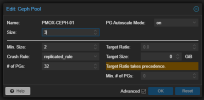Hi,
Currently I in the midst of exploring proxmox to replace vmware and i kinda new in VE technology.
For this setup i have
The purpose of this server is for internal use, maybe few VM for Window server for AD and Unix VM for developer usage.
Currently I in the midst of exploring proxmox to replace vmware and i kinda new in VE technology.
For this setup i have
- 3 x Dell PowerEdge r620
- Each of the server have
- 2 x 200GB SSD
- 4 x 1TB SAS
- 12 Core
- 9x GB ( I forgot the exact value )
- I choose zfs raid10 for proxmox VE installation and were left with 2.2TB available storage for VM usage for each of the server.
- Cluster created
The purpose of this server is for internal use, maybe few VM for Window server for AD and Unix VM for developer usage.




